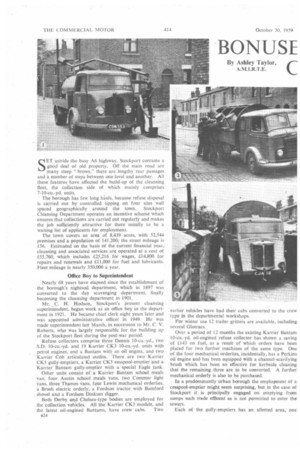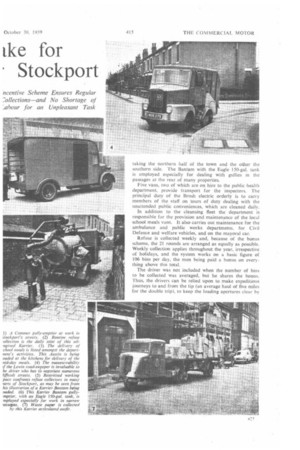BONUSE tke for Stockport
Page 58

Page 59

Page 60

If you've noticed an error in this article please click here to report it so we can fix it.
SET astride the busy A6 highway, Stockport contains a good deal of old property. Off the main road are many steep "brows," there are lengthy rear passages and a number of steps between one level and another. All these features have affected the build-up of the cleansing fleet, the collection side of which mainly comprises 7-10-cu.-yd. units.
The borough has few long hauls, because refuse disposal is carried out by controlled tipping on four sites well spaced geographically around the town. Stockport Cleansing Department operates an incentive scheme which ensures that collections are carried out regularly and makes the job sufficiently attractive for there usually to be a waiting list of applicants for employment.
The town covers an area of 8,439 acres, with 52,544 premises and a population of 141,200; the street mileage is 156. Estimated on the basis of the current financial year, cleansing and associated services are operated at a cost of 155,760, which includes £25,216 for wages, £14,800 for repairs and renewals and £11,000 for fuel and lubricants. Fleet mileage is nearly 350,000 a year.
Office Boy to Superintendent
Nearly 68 years have elapsed since the establishment of the borough's nightsoil department, which in 1897 was converted to the day scavenging department, finally becoming the cleansing department in 1901.
Mr. . C. H. Hodson, Stockport's present cleansing superintendent, began work as an office boy in the department in 1921. He became chief clerk eight years later and was appointed administrative officer in 1949. He was made superintendent last March, in succession to Mr. C. V. Roberts, who was largely responsible for the building up of the Stockport fleet during the post-war period.
Refuse collectors comprise three Dennis 10-cu.-yd., two S.D. 10-cu.-yd. and 19 Karrier CK3 10-cu.-yd. units with petrol engines, and a Bantam with an oil engine, and two Karrier -C613 articulated outfits. There are two Karrier CK3 gully-emptiers, a Karrier CK3 cesspool-emptier and a Karrier Bantam gully-emptier with a special Eagle tank.
Other units consist of-a Karrier Bantam school meals van, four Austin school meals vans, two Commer light vans, three Thames vans, four Lewin mechanical orderlies, a Brush electric orderly, a Fordson tractor with Barnford shovel and a Fordson Dinkum digger.
Both Derby and Chelsea-type bodies are employed for the collection vehicles. All the Karrier CK3 models, and the latest oil-engined Bantams, have crew cabs. Two a24
earlier vehicles have had their cabs converted to the crew type in the departmental workshops.
For winter use 12 trailer gritters are available, including several Glotracs.
Over a period of 12 months the existing Karrier Bantam 10-cu.-yd. oil-engined refuse collector has shown a saving of £143 on fuel, as a result of which orders have been placed for two further machines of the same type. One of the four mechanical orderlies, incidentally, has a Perkins oil engine and has been equipped with a channel-scarifying brush which has been so effective for kerbside cleaning that the remaining three are to be converted. A further mechanical orderly is also to be purchased.
In a predominantly urban borough the employment of a cesspool-emptier might seem surprising, but in the case of Stockport it is principally engaged on emptying from sumps such trade effluent as is not permitted to enter the sewers.
Each of the gully-emptiers has an allotted area, one taking the northern half of the town and the other thc southern side. The Bantam with the Eagle 150-gal, tank is employed especially for dealing with gullies in the passages at the rear of many properties.
Five vans, two of which are on hire to the public health department, provide transport for the inspectors. The principal duty of the Brush electric orderly is to carry members of the staff on tours of duty dealing with the unattended public conveniences, which are cleaned daily_ In addition to the cleansing fleet the department is responsible for the provision and maintenance of the local school meals vans. It also carries out maintenance for the ambulance and public works departments, for Civil Defence and welfare vehicles, and on the mayoral car.
Refuse is collected weekly and, because of the bonus scheme, the 21 rounds arc arranged as equally as possible. Weekly collection applies throughout the year, irrespective of holidays, and the system works on a basic figure of 106 bins per day, the men being paid a bonus on everything above this total.
The driver was not included when the number of bins to be collected was averaged, but he shares the bonus. Thus, the drivers can be relied upon to make expeditious journeys to and from the tip (an average haul of five miles for the double trip), to keep the loading apertures clear by raking, and to give a hand with the bins when necessary.
While the vehicle is at the kerbside the bins are naturally brought out and tipped straight in; should it be away unloading, the loaders continue to bring them out to the kerbside where they await attention. To qualify for the bonus the men have to clear the same rounds on a given day of the week, a system which has been found to reduce the need for inspection. Householders are quick to notify the departmental office whenever their bins have not been cleared on the proper day.
Tips in use at present are at Brinnington, Bridgehill, Castle Farm and Tame Street. At all these places there are either natural or artificial depressions where controlled filling can be carried out, followed by covering with soil that has been stripped off housing estates.
When filling is complete and the ground has been grassed over, the districts will thus be provided with parks or playing fields in place of what would otherwise have been waste ground. In the particular case of Castle Farm the department is acting for a sports club, and is dealing with boggy ground by putting in layers of refuse, levelling and draining, and replacing the top layer of soil.
So that deliveries to the tips shall be handled more effectively the department has latterly taken control of trade refuse collections. Four of the vehicles are employed on such duties. Each of these machines is allocated a district and in this area is also responsible for making contact with the motor sweepers, which work on a beat system, and carrying their sweepings to the tip.
One of the Karrier Cob articulated outfits collects waste paper from shops and other business premises, this afterwards being baled and sent for salvage. Some recovery of cardboard cartons and tins is done at the tips.
The fleet livery of deep nut brown, with red for the wings and certain Other fittings, was selected as combining attractive shades and providing a finish which would not show dust and dirt so readily as some of the lighter colours. Drivers clean their own vehicles, which are afterwards inspected and, subject to a satisfactory report, the men concerned receive an extra 10s. weekly above their ordinary rate of pay.
Maintenance for the cleansing and other departments is carried out in the shops at the main depot, where the staff includes four fitters, a coachbuilder, two painters, a tyre attendant, and a blacksmith and tinsmith whose duties include welding. The maintenance side of the establishment is divided into a fitters' shop, a body shop, a paint shop and a tyre bay.
Greasing is performed in accordance with a monthly schedule. Other maintenance is also on a time basis. Spare units are used. The work done includes complete overhauls to bodies and power units.




















































































































